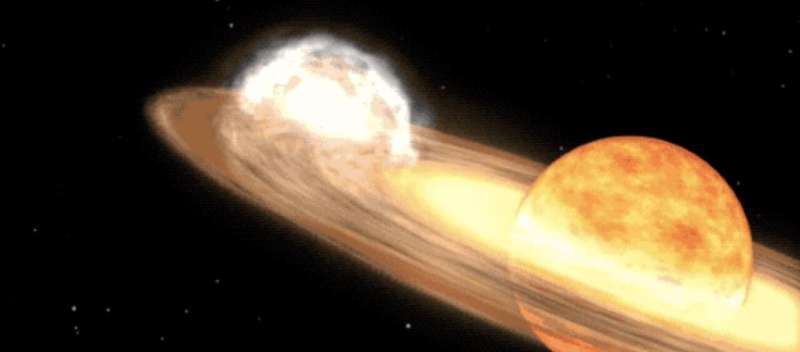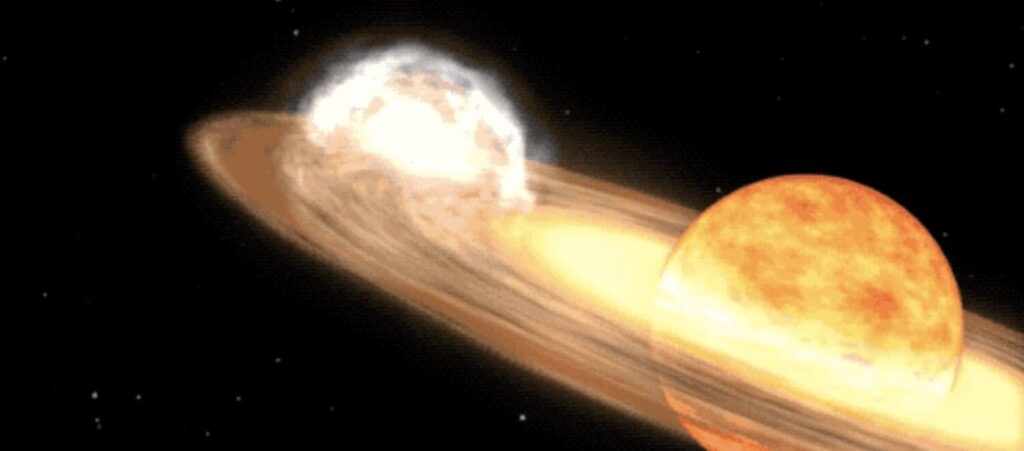
If you peer up at the constellation Corona Borealis—the Northern Crown—over the next several months, you may catch a glimpse: Astronomers predict that sometime this year, a new star will appear in the night sky, growing as bright as the North Star, then vanishing in a matter of days.
The source of that pinprick of light is a stellar system roughly 3,000 light-years from Earth called T Coronae Borealis, or T CrB. There, two stars circle each other, interacting in ways that—like clockwork—produce a powerful eruption of energy about once every 80 years—an event called a recurrent nova. T CrB became visible briefly in 1946, and scientists suspect that it’s on the verge again.
David Wilson is an astrophysicist and research associate at the Laboratory for Atmospheric and Space Physics (LASP) at CU Boulder who studies the ultraviolet light that stars emit.
While astronomers wait for T CrB to burst, Wilson gives his take on what causes this impressive event—and how curious stargazers can catch a glimpse.
What is a nova?
A lot of people are familiar with the concept of a supernova, which is an exploding star at the end of its life. In contrast, the word “nova” in this case just means a new star. People have known about these novae for thousands of years. They would see a new star in the sky that wasn’t there before. Then it would fade away again.
How does that happen?
In this case, it’s a pair of dying stars next to each other. Usually, you have a white dwarf, which is the leftover core from when a star like the sun reaches the end of its life. It blows off its outer layers and leaves behind this very small and very dense object. It’s about the size of the Earth.
If you put another star next to a white dwarf, it gets really interesting. The white dwarf’s companion star will expand out into a second star, in this case a red giant. The outer layers of the red giant start feeling gravitational attraction from the white dwarf. You get a flow of material, mostly hydrogen, off the companion star and onto the white dwarf where it forms a disk, then falls into the star itself.
You start piling hydrogen onto the white dwarf, and, eventually, that hydrogen gets so dense that it starts nuclear fusion.
What is nuclear fusion? Is that like a nuclear bomb?
A hydrogen bomb effectively the size of the Earth. A large fraction of the hydrogen will fuse and cause a massive explosion, and the star will get much, much brighter, then fade away over time.
Does this happen a lot?
Novae are fairly common. We detect one every few years. Most of them probably do recur, but it’s on the scale of millions of years. What’s interesting about systems like T CrB is that it happens quick enough for us to know about it. We know of about 10 of these recurrent novae in the Milky Way, and there are a few more candidates where all the physics seem right.
Is that unusual in astronomy—to have something occur so quickly?
Often in astronomy, we talk about like things that happen over millions of years, like the evolution of galaxies, or we talk about things that happen all the time, like flares coming from the sun. It’s strange to encounter an event that’s on the scale of a human lifetime, where someone might just remember it.
How do we know it’s about to happen again?
T CrB last went off in 1946 and before that in 1866. It did the same thing both times: Ten years before it exploded, it got somewhat brighter. Then just before the explosion, it dipped in brightness.
In the last few years, T CrB seemed to get brighter. That got people thinking, “Hang on. It’s going to blow up in the next 10 years or so.” Then at the end of last year, it started going down again. It’s a smoking gun that it is almost certainly going to blow up this year.
How does this event connect to your own research?
I study binaries where the white dwarf and its companion star are not quite close enough for material to flow from one to the other. But they do allow us to study stellar winds, or the flow of charge particles that all stars emit constantly. In these systems, the white dwarf sweeps through the wind from its companion, and you can see that imprint from the wind falling onto the white dwarf.
The stellar wind can have a huge effect on planets, but it’s really hard to measure from other stars. We rely on these white dwarfs to do that.
How can stargazers see this event?
It’s going to be about as bright as the north star, which isn’t the brightest star. There are about 120 stars brighter in the sky.
The best thing to do if you want to see it is to get to know the patch of sky where T CrB is, which is in the northeast at about 9 o’clock at the moment. As the year goes on, it’s going to get easier to see. The constellation Corona Borealis, the Northern Crown, will be high overhead in the summer.
If you get to know this patch of sky, you’ll see when it changes.
Provided by
University of Colorado at Boulder
Citation:
Q&A: How to catch a glimpse of a new star about to appear in the night sky (2024, April 29)
retrieved 30 April 2024
from https://phys.org/news/2024-04-qa-glimpse-star-night-sky.html
This document is subject to copyright. Apart from any fair dealing for the purpose of private study or research, no
part may be reproduced without the written permission. The content is provided for information purposes only.
